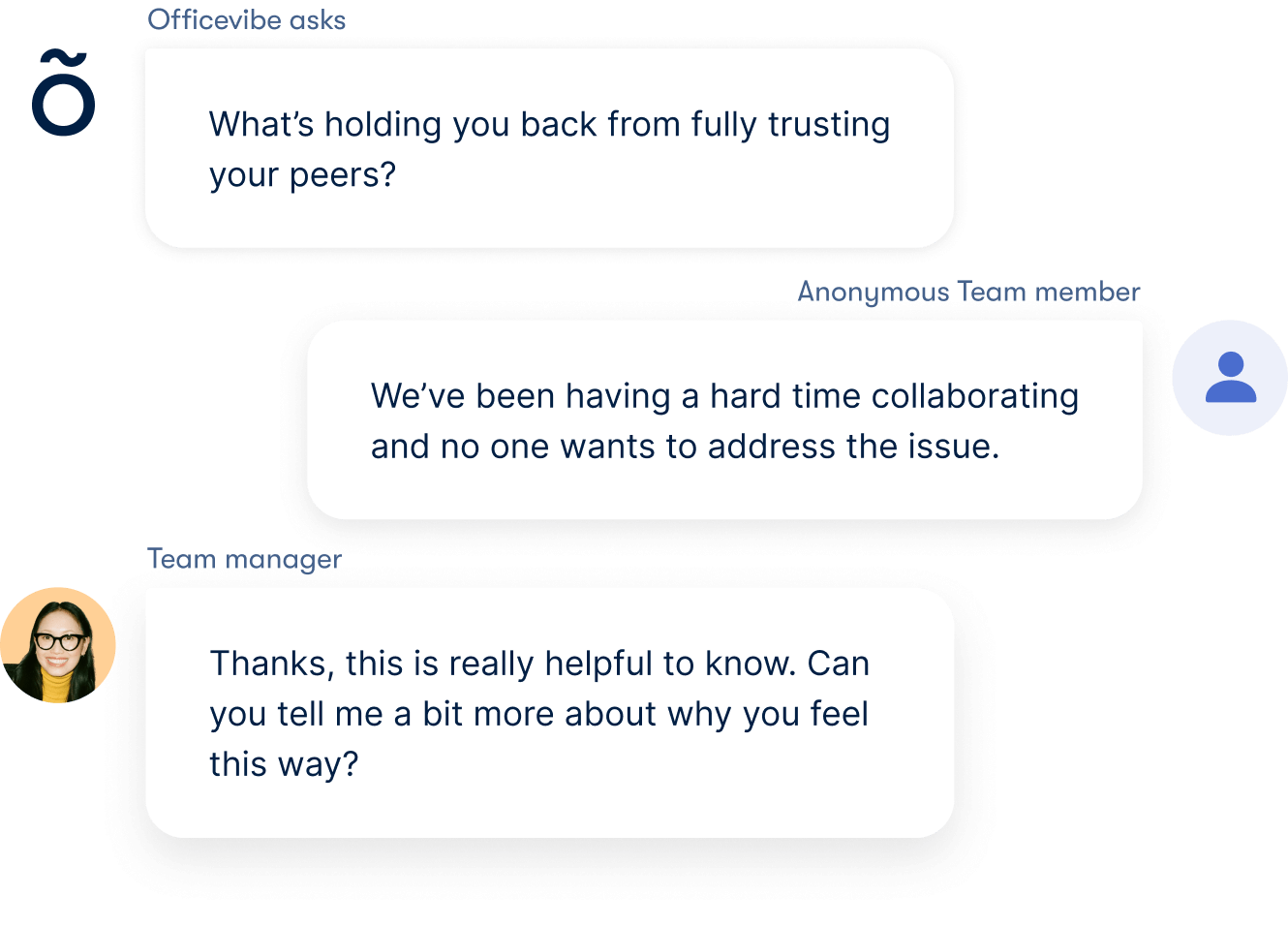An effective employee feedback system gives your organization a real competitive edge. It’s a powerful way to leverage your investment in human capital, keeping your workforce motivated and productive.
But not all feedback loops are created equal. To get optimal outcomes, you need to set up your feedback system the right way.
So we’ve created this quick guide to help you dodge the potential bullets and achieve the best results. You’ll discover what an employee feedback system is, the best way to use one, and best practices for implementation.
Assess your organization’s employee experience in minutes

Get the most out of your employee feedback system
- What is an employee feedback system?
- How to implement an employee feedback system
- The importance of collecting employee feedback
- How your employee feedback system enhances the employee experience
- Leverage the power of technology to enhance employee satisfaction
- Employee engagement: accelerate the pace of change
What is an employee feedback system?
The phrase ‘employee feedback system’ describes a setup that helps you take the pulse of employee sentiment to gauge factors such as employee engagement, job satisfaction, and other metrics.
In any organization, employees are critical stakeholders who have a significant influence on success. They represent a significant investment, yet there can be times when their thoughts and opinions feel undervalued. Such an impression can lead to frustration, poor team morale, and high staff turnover.
On the other hand, an organization that leverages a feedback system has the opportunity to be much more successful. Such feedback surfaces issues quickly so that so they can be addressed and resolved. Plus, employees can contribute new ideas that help to accelerate success still further.
Feedback loops are easy to initiate and bring a whole raft of benefits. Any business hoping to become an industry leader can benefit from surveying existing team members. And thanks to today’s sophisticated software technology, it’s surprisingly easy to do just that.
How to implement an employee feedback system
We've got you covered if you're wondering how to get employee feedback. There are many different ways to gather the views and opinions of employees.
The option that’s best for you may depend on factors such as:
- The size of the organization
- Where your employees are located
- Whether you have remote employees
- The technology employees have access to
But there’s no reason to let any constraints prevent you from gathering responses. Even a simple system can yield a wealth of valuable information you can use to your advantage.
Start with an informal feedback loop
Many organizations dip their toes in the water using a purely informal system to collect feedback. Options for achieving this include:
- Setting up a whiteboard (online or offline) where employees can add ideas and suggestions
- Having a manager’s open-door policy so team members feel encouraged to share without restraint
- Inviting employees to share their thoughts and contribute ideas during regular team meetings
This kind of informal feedback is often two-way in nature. Managers can use employee feedback examples to give them a head start in managing tricky conversations.
An informal system does have its limitations. Without structure, good ideas may get forgotten, and the data can be hard to analyze.
Create a traditional employee feedback system
One way to step up from an informal approach is to implement a more traditional system. This system may involve surveying employees by email and then collating the responses.
For further analysis, centralize feedback in an Excel spreadsheet or Google Sheet. This method can be a more organized improvement from the less formal approach but still leaves a lot desired.
Evaluating a large number of responses soon becomes unwieldy and impractical. Once again, the inevitable consequence is that critical feedback is overlooked or misunderstood.
Use a software-based system to collect feedback
The best solution of all is one that automates the whole process. That way, employees have a chance to air their views, vent any frustrations, and weigh in on relevant company initiatives. Busy managers get the vital feedback they need without spending hours analyzing data.
Thankfully, all of this is possible using modern software. Feedback tools designed to measure the employee experience deliver priceless data and help create an engaged workforce.
These feedback systems typically begin with an employee engagement survey that asks a wide range of pertinent questions. The software automatically gathers and analyzes the data, delivering critical insights into employee satisfaction.
A software-based employee feedback system such as Officevibe helps managers:
- Give employees a safe space for honest communication by collecting feedback anonymously.
- Get answers on important topics by sending custom surveys to ask specific open-ended questions to their team.
- Turn feedback into conversations, prompting further questions to get more details, and discuss the next steps while employees can choose to stay anonymous or not.
- Easily share survey reports to discuss with their team or company leadership.
- Stay in sync with their distributed or remote team sentiment so they can spot signs of disengagement early and stay connected with direct reports any time, from anywhere, all in one place.
Give feedback to employees
Hand-in-hand with collecting feedback from your team is giving employee feedback, too!
People share their views in hopes of feeling heard—approach feedback conversations openly and without judgment. As you listen with empathy, consider how you can respond.
Sometimes they will be looking for a resolution, and sometimes you're acting just by giving them an open forum to speak. Seek opportunities to support in the best way possible and provide feedback in the same form you would like to receive it.
Giving feedback doesn't always have to fall solely under a manager's responsibility. An alternative or additional approach to offer employees is 360-degree feedback.
In this system, team members receive feedback from many different team members to help them improve. It's usually a more formal, structured approach that doesn't happen all too frequently as it involves many players. A 360-degree feedback approach does help to eliminate bias from one source of feedback and helps people understand how they are fitting in.
Set out to turn feedback into conversations, and you'll naturally create a continuous loop of fruitful exchange, build trust, and deepen relationships with your team members.
The importance of collecting employee feedback
No organization can afford to rest on its laurels in a competitive environment. There’s a compelling need to keep improving and staying one step ahead. Standing still is a recipe for being left behind as more nimble competitors forge ahead.
Our employee feedback statistics show that 39% of employees don’t feel appreciated at work. When managers do make a concerted effort, the difference is astonishing. And it starts with knowing where to direct your intention! How do you find out? By getting feedback.
Gathering continuous feedback and acting on it can be a game-changer. A series of small improvements add up to transformational change very quickly. An effective feedback system can bring a more satisfying employee experience and an enhanced company culture.
A solid employee feedback strategy helps in many ways:
Complement annual reviews
The annual appraisal is the most widely-used feedback process of all. And while it certainly has value, it also has limitations.
An event that collects employee feedback once a year will always show up a little late to the game. Significant issues or wins deserving recognition may go unnoticed for twelve months, marking missed opportunities.
By complementing the performance review with a regular feedback loop, you can eliminate this problem. Your employee engagement survey will help you achieve better performance management throughout the entire year.
Understand true employee sentiment
Some employees may be reluctant to criticize their managers or the corporate culture for fear of reprisals. Others may be too shy to speak up.
Unexpressed feedback can lead to managers being oblivious to critical problems or missing out on potentially great ideas. Fortunately, you can prevent that.

Employee feedback systems provide an innovative solution, as most software tools allow for anonymous employee feedback survey responses. Team members can express their concerns freely, and everyone gains from uninhibited idea-sharing.
Achieve continuous improvement
One of the most significant advantages of a feedback system is that it serves to inspire continuous improvement.
Modern companies schedule employee feedback software to conduct employee surveys automatically and regularly. A key here is to stay consistent!
You start collecting vast and valuable information, providing detailed insights into how team members feel and what they care about.
Of course, gathering and analyzing the data is not enough. Next up is that you must act on the matters raised as quickly as possible to reap the benefits.
For example, if several employees say they don’t get enough feedback from a particular team leader, it’s time to talk to the manager in question. Encourage better communication and discuss how this benefits everyone in the organization.
If you are committed to making ongoing improvements based on feedback received, you can look forward to increased employee engagement, commitment, and productivity.
How your employee feedback system enhances the employee experience
A good feedback setup provides important feedback to the management team, but it’s critical for employees, too:
Give employees a voice
With a positive feedback loop, your employees will love sharing their views and ideas. Instead of feeling like a small cog in a big machine, they will know their opinions matter and make a difference.
Remove friction and frustrations
A problem that managers may not notice might be something major brewing within the team. Left unchecked, it can escalate and take managers by surprise.
For example, if one team member frequently brings a negative attitude to a specific task, a manager who doesn't have all the visibility might be unaware. Over time, this negative energy could weigh on others or affect objectives.
A feedback system provides employees with an easy way to raise such concerns before morale drops.
Increase future engagement
When people see their contributions making a difference, employee engagement soars. Replying to employee feedback helps dramatically. Team members will be encouraged to offer more ideas or emboldened to highlight negative issues that worry them.
Our research shows that 63% of employees feel they don’t get enough praise. So if you not only act on their feedback and praise their contribution, you have a winning strategy for happy employees. It only takes a moment to recognize employees and their efforts, but it makes a big difference.

Employee feedback best practices
The field of employee feedback is developing rapidly, so it makes sense to stay up-to-date with the latest ideas and best practices.
Here are some proven tips to give you a head start in the race for competitive advantage:
- Gather feedback often: mood can change quickly, and you need to understand how employees feel right now (not months ago)
- Schedule feedback collection to occur automatically: ditch error-prone manual systems and manage with software instead
- Act promptly on feedback received: action that occurs months after an issue arises is almost useless. Take action fast!
- Acknowledge, reward & praise: help employees to understand that there is real value in getting involved
Leverage the power of technology to enhance employee satisfaction
While it's possible to gather employee feedback the old-fashioned way, putting cutting-edge technology to work makes much more sense. That’s why so many organizations choose the Officevibe Employee Feedback Tool.
It’s an easy way to automate and organize how you collect anonymous feedback from employees. No matter how large or small your team is (or where your people are located), you get the data and insights you need to gauge employee happiness and satisfaction.
Using quick Pulse Surveys, you can get real-time feedback to stay on top of current sentiment and then dig deep to discover what you really need to know. Employees can share anonymous feedback with their manager easily, at any time.
Employee engagement: accelerate the pace of change
Tesla CEO, Elon Musk, says “what matters is the pace of innovation.” Companies that utilize an employee feedback system can accelerate change in their businesses, having an honest account of reality and using employees' best ideas to flourish.
That’s a fantastic way to improve employee retention, boost morale and keep your employees engaged. Implement such a system in your organization, and you may be amazed at the outcome.
Equip HR and managers with tools to engage, recognize, and drive performance.




